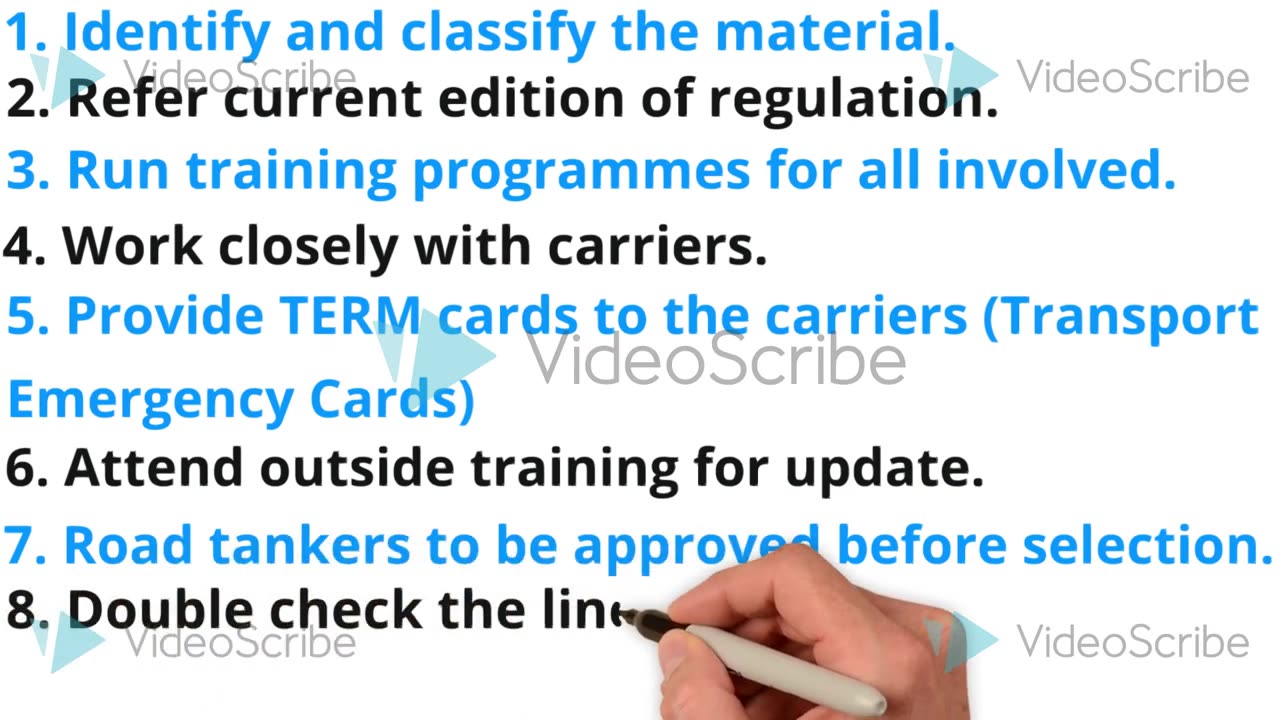Premium Only Content

Safety In Transportation Of Chemicals-- Safety In Chemical Transportation Rules-- Chemical Safety--
### **Safety in Transportation of Chemicals: Rules and Best Practices**
The transportation of chemicals involves inherent risks such as spills, leaks, and accidents, which can endanger lives, property, and the environment. Following established safety rules and best practices ensures chemical safety during transportation.
---
### **1. General Rules for Chemical Transportation**
- **Proper Classification**:
- Classify chemicals according to their hazard type (e.g., flammable, toxic, corrosive, reactive).
- Use Globally Harmonized System (GHS) classifications and UN numbers for universal understanding.
- **Appropriate Packaging**:
- Use containers approved for hazardous materials (HAZMAT) that are durable, leakproof, and chemically compatible.
- Ensure caps and seals are secure to prevent spills.
- **Labeling and Documentation**:
- Affix hazard warning labels and placards on containers and transport vehicles as per regulations.
- Include shipping papers with detailed information, such as the material's identity, hazards, and emergency response actions.
---
### **2. Vehicle and Equipment Requirements**
- **Vehicle Standards**:
- Use vehicles designed for chemical transport, such as tankers for liquids or flatbeds for large containers.
- Equip vehicles with spill kits, fire extinguishers, and emergency response equipment.
- **Vehicle Maintenance**:
- Regularly inspect vehicles for mechanical issues, leaks, or corrosion.
- Ensure braking systems, tires, and safety devices are in optimal condition.
- **Containment Systems**:
- Use secondary containment (e.g., spill pallets, liners) for extra protection during transport.
---
### **3. Driver and Personnel Safety**
- **Training**:
- Ensure drivers are HAZMAT-certified and trained in emergency response, chemical handling, and transportation regulations.
- Conduct regular refresher courses and drills.
- **Personal Protective Equipment (PPE)**:
- Equip personnel with gloves, goggles, respirators, and other necessary PPE.
- Ensure PPE is readily accessible during loading, unloading, and emergency situations.
---
### **4. Loading and Unloading Procedures**
- **Safe Handling**:
- Use mechanical aids (e.g., forklifts, cranes) to minimize manual handling of heavy containers.
- Follow proper lifting techniques to prevent accidents.
- **Securing Loads**:
- Properly secure containers to prevent shifting or falling during transit.
- Use straps, braces, or locks for added stability.
- **Ventilation**:
- Ensure adequate ventilation during the transfer of volatile chemicals.
---
### **5. Transportation Routes and Scheduling**
- **Route Planning**:
- Avoid densely populated areas, tunnels, and water crossings whenever possible.
- Select routes with minimal risk of accidents and easy access to emergency services.
- **Time Restrictions**:
- Transport chemicals during off-peak hours to minimize exposure to the public.
- **Weather Considerations**:
- Avoid transporting chemicals during adverse weather conditions like heavy rain, snow, or high winds.
---
### **6. Regulatory Compliance**
- **Local and International Laws**:
- Comply with regulations such as DOT's HAZMAT regulations, OSHA standards, and the International Maritime Dangerous Goods (IMDG) Code for shipping.
- Ensure all documentation, including permits, manifests, and SDS, is in order.
- **Placarding and Marking**:
- Follow guidelines for placarding based on chemical type and quantity being transported.
- **Security**:
- Secure vehicles during stops to prevent unauthorized access or theft.
- Monitor shipments through GPS or other tracking systems.
---
### **7. Emergency Preparedness**
- **Response Plans**:
- Develop an Emergency Action Plan (EAP) specific to chemical spills, leaks, or accidents.
- Train drivers and responders in spill containment, evacuation, and first aid.
- **Emergency Contacts**:
- Provide drivers with a list of emergency contacts, including local fire departments and chemical response teams.
- **Communication**:
- Equip vehicles with communication devices to report emergencies promptly.
---
### **8. Common Hazards and Preventative Measures**
- **Spills and Leaks**:
- Prevent by using high-quality seals and inspecting containers before transit.
- Address immediately with absorbent materials and spill kits.
- **Explosions and Fires**:
- Mitigate by avoiding static electricity, open flames, or heat sources near flammable materials.
- **Contamination**:
- Prevent by separating incompatible chemicals and using clean transport vehicles.
---
### **Key Takeaways for Chemical Safety in Transportation**
1. Proper classification, labeling, and documentation are essential.
2. Use approved vehicles and packaging.
3. Ensure drivers and handlers are trained and equipped with the right tools and PPE.
4. Prepare for emergencies with well-documented response plans.
5. Adhere to all local, national, and international regulations.
Would you like help creating a transportation checklist or emergency response guide specific to your operations?
-
 19:56
19:56
inspirePlay
1 day ago $0.01 earnedWalking with Lions & Facing Africa’s Wild Side | Safari Adventure with the Grid Championship Crew!
2.57K -
 10:50
10:50
RTT: Guns & Gear
1 day ago $0.34 earnedBudget Friendly Carry 2011: EAA Girsan Brat 2311
5.4K1 -
 3:49:06
3:49:06
Alex Zedra
15 hours agoLIVE! New Game | Nuclear Nightmare
97.4K13 -
 25:08
25:08
MYLUNCHBREAK CHANNEL PAGE
1 day agoUnder The Necropolis - Pt 2
280K64 -
 1:45:59
1:45:59
Spittin' Chiclets
1 day agoCanadian Chokejob - Game Notes Live From Chicago - 12.28.2024
259K32 -
 9:18
9:18
Space Ice
1 day agoThe Guyver - Alien Bug Suits, Exploding Dragons, & Mark Hamill - Weirdest Movie Ever
164K26 -
 9:31
9:31
Silver Dragons
1 day agoSilver Has Failed - Can it Set the Record Next Year? THIS BANK SAYS YES!
3.23K2 -
 7:08
7:08
GBGunsRumble
18 hours agoGBGuns Range Report 28DEC24
1.75K -
 1:19
1:19
LimitlessAmbition
5 hours ago $0.09 earnedHow the Discipline of Self-Respect Will Change Your Life Forever
1.5K -
 12:46
12:46
RealReaper
2 days ago $9.24 earnedMufasa is a Soulless Cash Grab
96K12